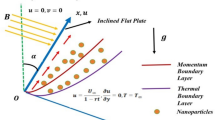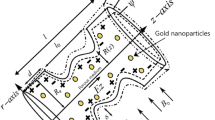Abstract
An analytical study is presented for couple stresses effects on MHD peristaltic transport of a non-Newtonian Jeffery nanofluid. The fluid flows through a porous media between co-axial tubes under long-wavelength assumption. The inner tube is uniform, while the outer flexible tube has a sinusoidal wave traveling down its wall. Homotopy perturbation method is used to obtain analytical solutions which satisfies the governing equations. Numerical results for the behaviors of the axial velocity, temperature and nanoparticles with other physical parameters are obtained. Several graphs for these results of physical interest are displayed and discussed in detail.



Similar content being viewed by others
Abbreviations
- B :
-
The wave amplitude
- \( \underline{B} \) :
-
The magnetic field \( = (B_{0} ,0,0) \)
- c :
-
The propagation velocity
- D :
-
The radius of outer tube
- Da :
-
Darcy number, defined by Eq. (20)
- D B :
-
Brownian diffusion coefficient
- D T :
-
Thermophoretic diffusion coefficient
- \( \underline{E} \) :
-
The electric field
- Ec :
-
Eckert number, defined by Eq. (20)
- F :
-
The nanoparticle phenomena
- f 0 :
-
Nanoparticles at \( {\text{r}} = {\text{r}}_{1} \)
- f 1 :
-
Nanoparticles at \( {\text{r}} = {\text{r}}_{2} \)
- \( \underline{I} \) :
-
The identity tensor
- \( \underline{J} \) :
-
The current density
- k R :
-
The mean absorption coefficient
- K :
-
Thermal conductivity
- \( \kappa^{*} \) :
-
The permeability parameter
- M :
-
The magnetic field parameter, defined by Eq. (20)
- N b :
-
Brownian motion parameter, defined by Eq. (20)
- N t :
-
The thermophoresis parameter, defined by Eq. (20)
- P :
-
The fluid pressure
- Pr:
-
Prandtl number, defined by Eq. (20)
- Q :
-
The radiative heat flux
- R :
-
Radiation parameter, defined by Eq. (20)
- Re:
-
Reynolds number, defined by Eq. (20)
- \( \underline{S} \) :
- t :
-
The time
- T :
-
The fluid temperature
- T 0 :
-
Temperature at \( {\text{r}} = {\text{r}}_{1} \)
- T 1 :
-
Temperature at \( {\text{r}} = {\text{r}}_{2} \)
- \( \underline{V} \) :
-
The velocity vector
- \( \alpha \) :
-
The couple stress fluid parameter, defined by Eq. (20)
- σ :
-
The electrical conductivity
- σ*:
-
Stefan Boltzmann constant
- ε :
-
The amplitude ratio
- \( \eta ,\,\overline{\eta } \) :
-
Couple stress constants
- \( \dot{\gamma } \) :
-
The shear rate
- λ :
-
The wavelength
- \( \lambda_{1} \) :
-
The ratio of relaxation to retardation times
- \( \lambda_{2} \) :
-
The retardation time
- \( \mu_{f} \) :
-
The dynamic viscosity of fluid
- µ e :
-
The magnetic permeability
- \( \rho_{f} \) :
-
The fluid density
- \( \rho_{p} \) :
-
The particle density
- \( (\rho c)_{f} \) :
-
Heat capacity of the fluid
- \( (\rho c)_{p} \) :
-
Effective heat capacity of the nanoparticle material
References
Abbasi MF, Hayat T, Ahmad B (2015) Peristaltic transport of copper–water nanofluid saturating porous medium. Phys E Low Dimens Syst Nanostruct 67:47–53
Abou-zeid MY (2015) Homotopy perturbation method to gliding motion of bacteria on a layer of power-law nanoslime with heat transfer. J Comput Theor Nanosci 12:1–10
Abou-zeid MY (2016) Effects of thermal-diffusion and viscous dissipation on peristaltic flow of micropolar non-Newtonian nanofluid: application of homotopy perturbation method. Results Phys 6:481–495
Abou-zeid MY (2017a) Homotopy perturbation method to MHD non-Newtonian nanofluid flow through a porous medium in eccentric annuli with peristalsis. Therm Sci 21(5):2069–2080
Abou-zeid MY (2017b) Homotopy perturbation method for creeping flow of non-Newtonian power-law nanofluid in a nonuniform inclined channel with peristalsis. Z Naturforsch 72(10):899–907
Akbar NS, Nadeem S (2013) Intestinal flow of a couple stress nanofluid in arteries. IEEE Trans Nanobiosci 12:332–339
Alsaedi A, Ali N, Tripathi D, Hayat T (2014) Peristaltic flow of couple stress fluid through uniform porous medium. Appl Math Mech Engl 35:469–480
Eldabe NT, Abou-zeid MY (2014) Magnetohydrodynamic peristaltic flow with heat and mass transfer of micropolar biviscosity fluid through a porous medium between two co-axial tubes. Arab J Sci Eng 39:5045–5062
Eldabe NT, Abou-zeid MY (2017) Homotopy perturbation method for MHD pulsatile non-Newtonian nanofluid flow with heat transfer through a non-Darcy porous medium. J Egypt Math Soc 25:375–381
Eldabe NTM, Hassan AA, Mohamed MAA (2003) Effect of couple stresses on the MHD of a non-Newtonian unsteady flow between two parallel porous plates. Z Naturforsch 58a:204–210
Hayat T, Nisar Z, Ahmad B, Yasmin H (2015) Simultaneous effects of slip and wall properties on MHD peristaltic motion of nanofluid with Joule heating. J Magn Magn Mater 395:48–58
He JH (2005) Application of homotopy perturbation method to nonlinear wave equations. Chaos Solitons Fractals 26:695–700
Nadeem S, Akram S (2011) Peristaltic flow of a couple stress fluid under the effect of induced magnetic field in an asymmetric channel. Arch Appl Mech 81:97–109
Ramesh K, Devakar M (2015) Magnetohydrodynamic peristaltic transport of couple stress fluid through porous medium in an inclined asymmetric channel with heat transfer. J Magn Magn Mater 394:335–348
Rohsenow WM, Hartnett JP, Cho YI (1998) Handbook of heat transfer. McGraw-Hill, New York
Shit GC, Roy M (2014) Hydromagnetic effect on inclined peristaltic flow of a couple stress fluid. Alex Eng J. 53:949–958
Stokes VK (1966) Couple stresses in fluids, couple stresses in fluids. Phys Fluids 9:1709–1715
Wang XQ, Mujumdar AS (2007) Heat transfer characteristics of nanofluids: a review. Int J Therm Sci 46:1–19
Author information
Authors and Affiliations
Corresponding author
Additional information
Publisher's Note
Springer Nature remains neutral with regard to jurisdictional claims in published maps and institutional affiliations.
Appendix
Appendix
Rights and permissions
About this article
Cite this article
Abou-zeid, M.Y. Homotopy perturbation method for couple stresses effect on MHD peristaltic flow of a non-Newtonian nanofluid. Microsyst Technol 24, 4839–4846 (2018). https://doi.org/10.1007/s00542-018-3895-1
Received:
Accepted:
Published:
Issue Date:
DOI: https://doi.org/10.1007/s00542-018-3895-1




